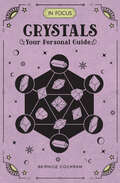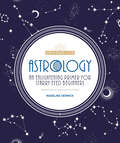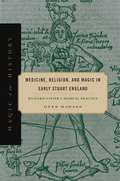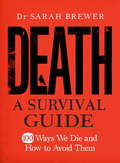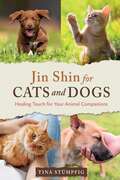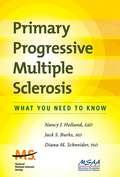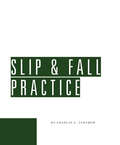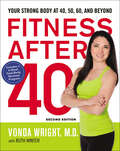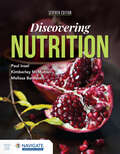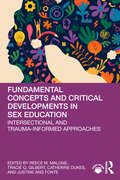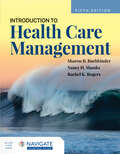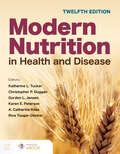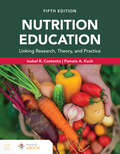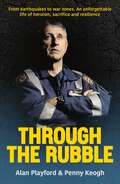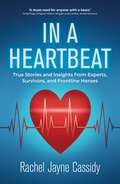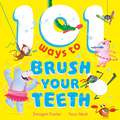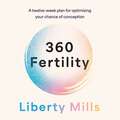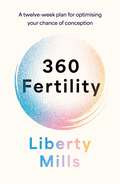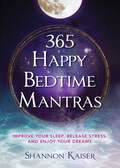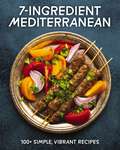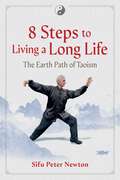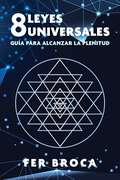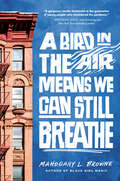- Table View
- List View
In Focus: Your Personal Guide (In Focus #2)
by Bernice CockramIn Focus Crystals describes over 100 crystals, from amethyst to zircon, complete with detailed summaries of their uses, qualities, and strengths, all expertly presented by crystal therapist Bernice Cockram. Included inside the back cover is a set of 7 double-sided grid cards that provide quick and easy reference to laying out crystals for healing, energizing, and more. Feeling creatively or spiritually blocked? Having trouble sleeping? Perhaps you are suffering from a physical ailment? Regardless of what may be plaguing you, the innate power within crystals can have tremendous healing effects. This artfully designed guide covers everything you need to know to benefit from their healing power, including how to:Work with crystal energySelect crystals from the various shapes availableCleanse crystals to clear away unwanted energyUse crystals for dowsing Work with chakras, auras, and the zodiacSet up crystal gridsThe In Focus series applies a modern approach to teaching the classic body, mind, and spirit subjects. Authored by experts in their respective fields, these beginner's guides feature smartly designed visual material that clearly illustrates key topics within each subject. As a bonus, each book includes reference cards or a poster, held in an envelope inside the back cover, that give you a quick, go-to guide containing the most important information on the subject.
Astrology: An Enlightening Primer for Starry-Eyed Beginners (The Awakened Life)
by Madeline Gerwick-BrodeurBecome enlightened and find out how your stars alignWhen it comes to translating astrological signs and symbols into real-world wisdom, your ignorance is off the charts! But don't worry, things will start looking up once you've brushed up on the basics and learned how to interpret the stars. And The Awakened Life: Astrology will show you how!This brand new edition offers a comprehensive history of astrology, instructions on how to interpret your birth chart, a reference guide for signs, planets, and houses, a unique breakdown of the concept of synastry, and even insightful tips on how astrology can help you with money and personal relationships!Discover the signs, how they relate to one another, and how you can incorporate your newfound astrological knowledge into your everyday life!
Medicine, Religion, and Magic in Early Stuart England: Richard Napier's Medical Practice (Magic in History)
by Ofer HadassThe astrologer-physician Richard Napier (1559-1634) was not only a man of practical science and medicine but also a master of occult arts and a devout parish rector who purportedly held conversations with angels. This new interpretation of Napier reveals him to be a coherent and methodical man whose burning desire for certain, true knowledge contributed to the contemporary venture of putting existing knowledge to useful ends.Originally trained in theology and ordained as an Anglican priest, Napier later studied astrological medicine and combined astrology, religious thought, and image and ritual magic in his medical work. Ofer Hadass draws on a remarkable archive of Napier’s medical cases and religious writings—including the interviews he claimed to have held with angels—to show how Napier’s seemingly inconsistent approaches were rooted in an inclusive and coherent worldview, combining equal respect for ancient authority and for experientially derived knowledge. Napier’s endeavors exemplify the fruitful relationship between religion and science that offered a well-founded alternative to the rising mechanistic explanation of nature at the time.Carefully researched and compellingly told, Medicine, Religion, and Magic in Early Stuart England is an insightful exploration of one of the most fascinating figures at the intersection of medicine, magic, and theology in early modern England and of the healing methods employed by physicians of the era.
Death: A Survival Guide
by Dr Sarah BrewerWe all have a 100 per cent chance of dying - eventually. But when are you most at risk? Which are the world's biggest killers? And what can you do to postpone the inevitable? Death - A Survival Guide offers a unique insight into the biggest threats to life and limb in the industrialized world. Sarah Brewer's comprehensive and thorough survey of the most likely ways to die in the industrialized world looks at 100 causes of death from the most common such as heart disease, smoking related deaths and domestic accidents to the unusual and downright bizarre lightning strikes and animal attacks. This fascinating - and occasionally sideways - look at death and dying will help you understand the most common causes of death and how each one affects the human body. View at a glance statistics reveal who dies where, when and how often; lists of warning signs, symptoms and risk factors allow you to determine the chances of it happening to you; and finally case studies on prevention, treatment and cures describe the best steps you can take to avoid meeting your maker in this way. Aeroplane crash; Anaphylactic shock; Aortic aneurysm; Brain tumour; Breast cancer; Creutzfeldt-Jacob disease; Dehydration; Dementia; Domestic accidents; Heart attack; Influenza; Malaria; Occupational hazards at work; Over-exertion; Pulmonary Embolism; Respiratory failure.
Death: A Survival Guide
by Sarah BrewerWe all have a 100 per cent chance of dying - eventually. But when are you most at risk? Which are the world's biggest killers? And what can you do to postpone the inevitable? Death - A Survival Guide offers a unique insight into the biggest threats to life and limb in the industrialized world. Sarah Brewer's comprehensive and thorough survey of the most likely ways to die in the industrialized world looks at 100 causes of death from the most common such as heart disease, smoking related deaths and domestic accidents to the unusual and downright bizarre lightning strikes and animal attacks. This fascinating - and occasionally sideways - look at death and dying will help you understand the most common causes of death and how each one affects the human body. View at a glance statistics reveal who dies where, when and how often; lists of warning signs, symptoms and risk factors allow you to determine the chances of it happening to you; and finally case studies on prevention, treatment and cures describe the best steps you can take to avoid meeting your maker in this way. Aeroplane crash; Anaphylactic shock; Aortic aneurysm; Brain tumour; Breast cancer; Creutzfeldt-Jacob disease; Dehydration; Dementia; Domestic accidents; Heart attack; Influenza; Malaria; Occupational hazards at work; Over-exertion; Pulmonary Embolism; Respiratory failure.
Jin Shin for Cats and Dogs: Healing Touch for Your Animal Companions
by Tina Stümpfig• Includes body maps for both cats and dogs that clearly illustrate the positions of the Jin Shin Jyutsu energy points and explains how to work with them • Presents step-by-step illustrations and easy, brief explanations for point sequences for general health, first aid, and specific ailments, from ear mites and conjunctivitis to kidney infection, splinters, and anxiety • Provides sections with dog-specific and cat-specific ailments, organized by area of the body and symptoms, with recommended treatment points and sequences ARE YOU LOOKING FOR A GENTLE WAY to ease your cat&’s coughing or lighten the joint problems of your dog? Or maybe you want to relieve your pet&’s stress when going to the vet and help them recover after surgery? A soft touch method for harmonizing energy flow, Jin Shin Jyutsu is an excellent hands-on healing tool to support your animal companion&’s overall health and alleviate common ailments and injuries. By calmly placing your hands on certain energy points on your pet&’s body, you can release energetic blockages, strengthen the immune system, and stimulate their body&’s self-healing response. Easy step-by-step illustrations and body maps for both cats and dogs show how to use this simple system of two-point touch healing. From ear mites and conjunctivitis to kidney infection, splinters, and anxiety, just by holding certain points on the body of your cat or dog you can quickly relieve a symptom or trigger the start of a comprehensive healing process. Jin Shin Jyutsu not only improves their health and well-being but also offers an enjoyable moment of energetic exchange between you and your four-legged friend throughout all phases of life.
Primary Progressive Multiple Sclerosis
by Ph.D. Diana M. Schneider Ed.D. Nancy J. Holland Jack S. BurksThis book addresses address the wide variety of physical and emotional issues of people with the primary progressive forms of MS. This population experiences a steady decline in function without relapses, and disability tends to occur early in their disease course. It is associated with severe and unrelenting symptoms, and people with PPMS live without hope of a "cure."Chapters deal with the nature of the disease and its characteristics, as well as its comprehensive multidisciplinary management. These include medical and nursing care, physical and occupational therapy, social support, caregiver and family issues, and mental health and quality of life.This book is jointly sponsored by the National MS Society and the Multiple Sclerosis Association of America, which have made a major commitment to improving the lives of the approximately 12% of the MS population with the primary progressive forms of the disasease. This commitment reflects the realization that this has been an underserved population, and extensive resources are being.
Slip & Fall Practice
by Charles TurnbowPlaintiffs' attorneys lose 40% of their slip and fall cases. Failure to prove a causative link between the hazard and a negligent act of the defendant is the number one reason for these high losses. Charles Turnbow, attorney-engineering consultant on over 9,500 slip and fall cases, shows you how to prove causation (and how to efficiently screen out cases lacking it) in his highly-respected toolbook, Slip & Fall Practice: * Analyzing the mechanics of the fall to identify the cause * The most common cases and what they must have to win * Documenting the dangerous condition and the negligence that caused it * Establishing the duty of care * Proving control of the premises * Establishing actual or constructive notice * Showing that the hazard caused the injury Slip & Fall Practice is loaded with case evaluation strategies, illustrative fact patterns (with photos), discovery forms, expert witness checklists, case authorities, building code citations, model pleadings, trial preparation aids, and most important, timesaving and case-winning practice tips.
Fitness After 40: Your Strong Body at 40, 50, 60, and Beyond
by Ruth Winter Vonda WrightWith Fitness After 40, regain the energy and physique of a teenager in no time.Your body is getting older, those stairs are looking steeper, and your bones are cracking louder. The unavoidable fact is that your body is aging. However, that doesn&’t have to impact your fitness level. Forget how many candles were on your last birthday cake--if you exercise smarter, you can remain youthful, energetic, and strong.As an academic orthopedic surgeon and internationally recognized authority on active aging and mobility, Dr. Vonda Wright has created a unique medical program designed to target the fitness and performance needs of mature athletes. In this invaluable resource, Wright reveals how anyone can use flexibility, aerobic exercise, and strength training to maximize the benefits of their fitness regime.You will learn how to:Understand your body, and approach exercise in a new wayMaximize your fitness while minimizing injuryGain flexibility--no matter your ageBenefit from aerobic exerciseBuild strength through resistance trainingImprove balanceFitness After 40 for all maturing adults includes &“20 Minutes to Burn&” workouts, a six-week total-body plan, and the latest information on nutrition, injury prevention, joint preservation, and the mind/body connection for all maturing adults.
Discovering Nutrition
by Melissa Bernstein Kimberley McMahon Dr. Paul InselIncorporating the latest research and dietary guidelines, Discovering Nutrition, Seventh Edition introduces students to the fundamentals of nutrition with an engaging and personalized approach. Written with a diverse student population of nutrition majors and non-majors in mind, this text focuses on teaching behavior change and personal decision making with an emphasis on how our nutritional behaviors influence lifelong personal health and wellness, while also presenting up-to-date scientific concepts in several innovative ways. Thoroughly updated, the new seventh edition covers current nutrition topics of interest such as personalized nutrition, nutrigenomics, the obesogenic environment, gut health, microbiome, plant-based diet, functional foods, bioavailability, nutrition density, and gut microbiome. Feature boxes such as the new Lifestyle Medicine, Why Is This Important? Quick Bites, and more, ensure students learn practical nutrition information.
Fundamental Concepts and Critical Developments in Sex Education: Intersectional and Trauma-Informed Approaches
by Tracie Q. Gilbert Reece M. Malone Catherine Dukes Justine Ang FonteThis comprehensive resource equips emerging and experienced sexuality educators with contemporary frameworks for trauma-informed, equitable, and anti-oppressive education.It provides foundational principles for development and delivery, emphasizing inclusivity, accessibility, and intersectionality. Editors Malone, Gilbert, Dukes, and Fonte curate chapters by leading voices on topics such as historical perspectives, values, emotional intelligence, professional humility, reproductive justice, neurodivergence, sex work, kink, childhood and adolescent sexualities, faith-based education, social media, and entrepreneurship. Authors demonstrate decolonization, trauma-informed care, and equity in practice.With practical applications and reflective questions, this book is a vital guide for creating and teaching impactful, inclusive sex education for diverse audiences.
Introduction to Health Care Management
by Rachel Rogers Sharon B. Buchbinder Nancy H. ShanksCovering a range of healthcare settings, Introduction to Health Care Management, Fifth Edition provides a solid orientation to management in the health care discipline. Written for students just entering the field, this reader friendly text is filled with examples designed to engage the reader’s imagination, while addressing the important issues in healthcare management, such as ethics, cost management, strategic planning and marketing, information technology, human resources, and more. The new Fifth Edition integrates population health and information management throughout and offers new coverage of artificial intelligence (AI), the impact of COVID 19, and concepts and issues of diversity, equity, and inclusion (DEI). Many of the cases and exercises are new or significantly updated to reflect current healthcare management challenges, while research resources and references have been updated throughout.
Modern Nutrition in Health and Disease
by Karen E. Peterson Katherine L. Tucker Christopher P. Duggan Gordon L. JensenIntroducing the twelfth edition of Modern Nutrition in Health and Disease, a seminal text in the field of nutrition. Originally published in 1950, this revised print and digital edition—now in full-color—serves as both a comprehensive learning resource for undergraduate and graduate nutrition majors, and an authoritative reference for nutrition practitioners. Authored and edited by distinguished experts worldwide, this twelfth edition features new chapters on interprofessional practice, global food systems, precision nutrition, and more. With a focus on physiological nutrition principles and fully referenced with the latest scientific research, this edition showcases major advancements in understanding nutrition's role in disease prevention. It continues the tradition of providing in-depth information on various aspects of nutrition, making it an invaluable tool for undergraduates, graduate nutrition majors, and the medical community.
Nutrition Education: Linking Research, Theory, and Practice
by Isobel R. Contento Pamela A KochNutrition Education: Linking Research, Theory, and Practice, Fifth Edition is a practical and straightforward theory- and research-based guide for how to create, implement, and evaluate nutrition education that can change dietary behavior to improve the health of people and the planet. Built around the six-step DESIGN process for creating nutrition educational plans to be delivered to groups in person or indirectly through various physical and digital media along with plans for creating activities to provide environmental supports, this text also provides detailed nuts and bolts guidance to help students deliver these plans effectively through various media to a range of audiences or populations.
Through the Rubble: From Earthquakes to War Zones. A Story of Survival and Service
by Alan Playford Penny KeoghAn unforgettable life of heroism, sacrifice, and resilience.In Through the Rubble, Alan Playford recounts his extraordinary life, marked by the dramatic moment he emerged from the wreckage of the Newcastle Workers Club during the 1989 earthquake. Alan became a national hero after rescuing Norm Duffy from beneath the rubble. In news coverage that circled the globe, Alan embodied the courage and determination of paramedics whose lives inspire admiration. For the paramedic known as 'Scoop,' this was simply another day on the job. To those who know him best, it was his destiny. Alan has been at the heart of defining moments in Australian history and global conflict, moments that forever changed the practice of paramedicine and saved millions of lives. This gripping memoir traces Alan&’s remarkable career, from his early struggles to modernise the ambulance service and launch helicopter rescue in Australia, to his life-saving work in global conflict zones. Alan served on the frontlines in Rwanda, East Timor, and the Solomon Islands, providing aid in dangerous environments and rescuing countless lives from the brink of death. A pioneer in the field, in 1989 Alan founded the Westpac helicopter service, which has since been integral in saving lives nationally. His bravery continued during domestic crises like the 2003 Canberra bushfires, where his calm under pressure earned him Australia&’s highest honours. Alan shares dramatic moments of heroism and the emotional toll of a career spent on the frontlines. He reveals the psychological burdens borne by those who serve, offering a deep look into the personal sacrifices made to protect others. This memoir is both a thrilling account of one man&’s life of service and a testament to the resilience of the human spirit in the face of unimaginable odds. Alan Playford&’s Through the Rubble offers an unforgettable portrait of a true hero—someone whose courage, compassion, and determination have shaped paramedicine and saved countless lives, both in Australia and around the world.
In a Heartbeat: True Stories and Advice: Insights from Experts, Survivors, and Frontline Heroes
by Rachel Jayne Cassidy&‘If you&’re having symptoms that don&’t feel right, call Triple Zero. If it&’s not a heart issue, then that&’s OK. No one ever died of embarrassment.&’ Author Rachel Jayne Cassidy knows firsthand what it&’s like to be on the brink of life and death. After surviving a critical heart attack, she understands the challenges of heart health. Cardiovascular disease is the number one killer worldwide, impacting more than 500,000 Australians. Rachel emphasises for the lucky survivors that while recovery takes time, it is crucial to learn how to live and thrive after a heart event.In a Heartbeat delves into the emotional and physical complexities of dealing with heart disease, sharing real-life, emotionally raw stories that provide insight into the impact of this disease. From survivors to everyday heroes who, by a momentary twist of fate have saved a life, to the health professionals who work tirelessly behind the scenes to give seriously ill patients a second chance at life. This combination of insightful stories captures the full spectrum of experiences and provides a comprehensive understanding of heart health. This valuable guide features uplifting, inspiring accounts of human survival against all odds, alongside valuable heart health information from well-recognised cardiologists and health professionals across Australia. Inspiring stories include Strictly Ballroom star turned politician Paul Mercurio, former original yellow Wiggle Greg Page, aspiring First Nations entertainer Warrawatja Bell, little Arlo—the face of the 2023 Royal Children&’s Hospital appeal, former Chief Minister of the Northern Territory Michael Gunner, and many more. Rachel Jayne&’s journey as a heart attack survivor and heart health advocate provides her with deep personal insights and invaluable knowledge. She is dedicated to ensuring that those who have experienced a heart event find comfort and reassurance in this book, knowing they are not alone. Rachel Jayne hopes this book will spark a potentially lifesaving conversation.
101 Ways to Brush Your Teeth
by Imogen FosterBig teeth, small teeth, wonky teeth and chompy teeth. You can brush your teeth almost anywhere and doing anything!You can brush them balancing on one leg like a pink flamingo. You can brush them with a pal, like a crocodile. You can brush them while you ROAR like a lion.There are 101 ways to brush your teeth packed into the pages of this funny and totally ridiculous but REALLY helpful book. With tips on how to brush your teeth and fun facts about animals' real teeth throughout, this book will help help little readers get their teeth sparkling.
360 Fertility: A twelve-week plan for optimising your chance of conception
by Liberty Mills'360 Fertility brings the overwhelming and often heartbreaking process of a fertility struggle into manageable and relatable chapters' Katie Rollings, CEO & Founder, Fertility Action Network'Liberty nails it in this book' Dale Pinnock, aka The Medicinal ChefWith a foreword by Dr Karen Joash, Consultant in obstetrics and gynaecologyLiberty Mills was told at age 43 that she had a 0.7% chance of having another baby with her own eggs - and that was with the assistance of IVF. She and her partner decided to continue their fertility journey with the help of integrative medicine. After a lifestyle overhaul, she conceived her beautiful daughter naturally, and gave birth two weeks before her 45th birthday. Liberty now works as a Certified Integrative Health and Nutrition Coach helping to create bespoke programmes for both couples and single people hoping to conceive. In this book, she shares everything she has learned on her own journey and the knowledge she shares with her clients.360 Fertility is a practical 12-week-long programme focusing on getting you and/or your partner ready to maximise your chances of conception. With a holistic approach, this book focuses not just on your physical but also your mental health. The week-by-week structure is clear, easy to follow and full of practical and easily actionable advice - from getting your body and environment healthy, to working on your mindset, and from what supplements are key to the importance of sleep, exercise and so much more. There's also a bonus chapter containing everything you need to know about IVF.'360 Fertility brings the overwhelming and often heartbreaking process of a fertility struggle into manageable and relatable chapters' KATIE ROLLINGS, CEO & Founder, Fertility Action Network'Liberty nails it in this book' DALE PINNOCK, aka The Medicinal Chef
360 Fertility: A twelve-week plan for optimising your chance of conception
by Liberty Mills'360 Fertility brings the overwhelming and often heartbreaking process of a fertility struggle into manageable and relatable chapters' Katie Rollings, CEO & Founder, Fertility Action Network'Liberty nails it in this book' Dale Pinnock, aka The Medicinal ChefWith a foreword by Dr Karen Joash, Consultant in obstetrics and gynaecologyLiberty Mills was told at age 43 that she had a 0.7% chance of having another baby with her own eggs - and that was with the assistance of IVF. She and her partner decided to continue their fertility journey with the help of integrative medicine. After a lifestyle overhaul, she conceived her beautiful daughter naturally, and gave birth two weeks before her 45th birthday. Liberty now works as a Certified Integrative Health and Nutrition Coach helping to create bespoke programmes for both couples and single people hoping to conceive. In this book, she shares everything she has learned on her own journey and the knowledge she shares with her clients.360 Fertility is a practical 12-week-long programme focusing on getting you and/or your partner ready to maximise your chances of conception. With a holistic approach, this book focuses not just on your physical but also your mental health. The week-by-week structure is clear, easy to follow and full of practical and easily actionable advice - from getting your body and environment healthy, to working on your mindset, and from what supplements are key to the importance of sleep, exercise and so much more. There's also a bonus chapter containing everything you need to know about IVF.'360 Fertility brings the overwhelming and often heartbreaking process of a fertility struggle into manageable and relatable chapters' KATIE ROLLINGS, CEO & Founder, Fertility Action Network'Liberty nails it in this book' DALE PINNOCK, aka The Medicinal Chef
360 Fertility: A twelve-week plan for optimising your chance of conception
by Liberty Mills'360 Fertility brings the overwhelming and often heartbreaking process of a fertility struggle into manageable and relatable chapters' Katie Rollings, CEO & Founder, Fertility Action Network'Liberty nails it in this book' Dale Pinnock, aka The Medicinal ChefWith a foreword by Dr Karen Joash, Consultant in obstetrics and gynaecologyLiberty Mills was told at age 43 that she had a 0.7% chance of having another baby with her own eggs - and that was with the assistance of IVF. She and her partner decided to continue their fertility journey with the help of integrative medicine. After a lifestyle overhaul, she conceived her beautiful daughter naturally, and gave birth two weeks before her 45th birthday. Liberty now works as a Certified Integrative Health and Nutrition Coach helping to create bespoke programmes for both couples and single people hoping to conceive. In this book, she shares everything she has learned on her own journey and the knowledge she shares with her clients.360 Fertility is a practical 12-week-long programme focusing on getting you and/or your partner ready to maximise your chances of conception. With a holistic approach, this book focuses not just on your physical but also your mental health. The week-by-week structure is clear, easy to follow and full of practical and easily actionable advice - from getting your body and environment healthy, to working on your mindset, and from what supplements are key to the importance of sleep, exercise and so much more. There's also a bonus chapter containing everything you need to know about IVF.'360 Fertility brings the overwhelming and often heartbreaking process of a fertility struggle into manageable and relatable chapters' KATIE ROLLINGS, CEO & Founder, Fertility Action Network'Liberty nails it in this book' DALE PINNOCK, aka The Medicinal Chef
365 Happy Bedtime Mantras: Improve Your Sleep, Release Stress, and Enjoy Your Dreams (Happy Bedtime Mantras #1)
by Shannon KaiserFrom &“one of the freshest voices in mental health and wellness&” (Marci Shimoff, New York Times bestselling author), a year&’s worth of nightly practices to help you establish healthy sleep habits so that you can relax, de-stress, and dream deeply for a better well-being. Millions of Americans are struggling with sleep disorders or insufficient sleep, putting them at risk for numerous other health issues. For them, every night can feel like a losing battle. Now, 365 Happy Bedtime Mantras seeks to reverse the epidemic of poor sleep by helping you balance both the body and mind with self-love and relaxation-promoting mantras, meditations, and bedtime rituals. Whether you want to improve your quality of life with better sleep, effectively transform your evening routines, practice more self-care and self-love, or simply add more mindfulness moments to your life, you will find what you need in this wonderous book.
7-Ingredient Mediterranean: 100+ Simple, Vibrant Recipes
by Cider Mill PressTransport yourself to the sun-soaked shores of the Mediterranean with over 100 quick, effortless, and vibrant recipes all using just seven ingredients.Welcome to the Mediterranean, simplified. From the coastal regions of Italy to the spice markets of Morocco, these meals harness the power of a few select ingredients to create dishes that are rich in flavors and textures. This cookbook is designed to make healthy eating accessible and absolutely delicious, making it easy to incorporate balanced meals for heart health and longevity into your daily life. With seven ingredients there are infinite flavors—enjoy everything from zesty salads to hearty pastas, succulent seafood, and robust vegetarian options that explore the rich tapestry of Mediterranean cooking.Inside you&’ll find:100+ easy recipes for wholesome appetizers and sides, hearty mains, and refreshing dessertsNo-fuss meals perfect for busy weeknightsRecipes emphasizing fresh produce, whole grains, healthy fats, and lean proteins for nutritious meals that don&’t skimp on tasteEye-catching photography to showcase each dishSimplicity is the secret ingredient to extraordinary dishes. Get bold, authentic flavor without the complexity with 7-Ingredient Mediterranean.
8 Steps to Living a Long Life: The Earth Path of Taoism
by Sifu Peter Newton• Shares an eight-step process based on the life-prolonging and health-enhancing methodology of the Earth Path of Taoism• Includes practices focused on posture, breathing, mental health, energy flow, and meditation, as well as eight mind-body Daoyin longevity exercises, complete with illustrated instructions• Explores what causes premature aging and how to avoid it, along with longevity secrets of the legendary Eight ImmortalsACCORDING TO THE ANCIENT CHINESE SAGES, the way to achieve health, longevity, and enlightenment starts with the Earth Path of Taoism, which advises us to nurture the body, calm the mind, and stir the spirit.In this practical guide, Sifu Peter Newton explains the principles and practices of the path and provides an easy-to-follow eight-step process to integrate this longevity wisdom into daily life. Drawing from tai chi and qigong, he explores how to avoid premature aging, highlights body posture as well as a flexible outlook on life, and looks at profound breathing. As we work with the rhythms of yin and yang in our bodies and lives, we discover the benefits of meditation and the practice of "stirring the shen"—the notion of circulating primordial shen, the root of life. Last but not least, eight clearly explained mind-body Daoyin longevity exercises show how to redirect and refine qi, the internal energy of the body.Interwoven with longevity pearls of wisdom, this illustrated guide shows that regardless of physical ability or age, the Taoist Earth Path is accessible to everyone. Without doubt, we all share the ability to live a long and healthy life.
8 leyes universales: Guía para alcanzar la plenitud
by Fer Broca• Explica ocho de las leyes universales en un lenguaje directo y práctico para que puedas aplicarlas a tu vida de inmediato• Ayuda a comprender cómo funciona el universo, como una cadena infinita de causas y efectos que influyen en tu presente• Revela estrategias para lograr vivir en paz, sin importar las circunstancias que te rodeanDesde muy pequeño, Fer Broca empezó a buscar respuestas a sus profundas inquietudes espirituales. Tras sumergirse en las enseñanzas de culturas tan distantes en tiempo y espacio como la cristiana, la judaica, la hindú, la japonesa, la náhuatl y otras, además de iniciarse en el camino del chamanismo, el autor logró compilar las 8 leyes universales imprescindibles para alcanzar la plenitud vital.Con un característico estilo amistoso, y con sugerencias y ejemplos claros, Fer Broca desarrolla los principios de unicidad, generación, resonancia, karma, dharma, wu wei, ollin y la paz, para que puedas aplicarlos en tu cotidianeidad y hacer crecer tu espiritualidad. Las anécdotas del autor enriquecen la lectura y te ayudarán a comprender los sucesos de tu vida desde un punto de vista más amplio. ¿Conoces el juego del ego y cómo afecta tu conducta? ¿Cuáles son los pensamientos limitantes que han frustrado tus sueños? Fer Broca los revelará y te mostrará cómo hacerles frente para reconectar con tu esencia.Las 8 leyes universales te permitirán tomar decisiones desde tu centro y en plena consciencia. Con la guía de Fer Broca realizarás un viaje hacia tu interior, con el objetivo de que encuentres equilibrio, armonía y paz que, en palabras del autor, constituyen "la felicidad verdadera".
A Bird in the Air Means We Can Still Breathe
by Mahogany L. BrowneIn this poignant mixed voice, mixed form collection of interconnected prose, poems and stories, teen characters, their families, and their communities grapple with the COVID-19 pandemic. Amidst fear and loss, these New York City teens prevail with love, resilience and hope. From the award-winning author of Chlorine Sky and Vinyl Moon."[A] gorgeous, tender testament to the generation of young people who shouldered the pandemic.&”--Brendan Kiely, award-winning and New York Times bestselling authorGrief, pain, hope, and love collide in this short story collection. In New York City, teens, their families, and their communities feel the brunt of the COVID-19 pandemic. Amidst the fear and loss, these teens and the adults around them persevere with love and hope while living in difficult circumstances: Malachi writes an Armageddon short story inspired by his pandemic reality.Tariq helps their ailing grandmother survive during quarantine.Zamira struggles with depression and loneliness after losing her parents.Mohamed tries to help keep his community spirit alive.A social worker reflects on the ways the foster system fails their children.From award-winning author Mahogany L. Browne comes a poignant collection of interconnected prose, poems, and lists about the humanity and resilience of New Yorkers during the Covid-19 pandemic.
